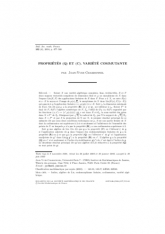Propriétés (Q) et (C). Variété commutante
Properties $({\bf Q})$ and $({\bf C})$. Commuting variety

- Consulter un extrait
- Année : 2004
- Fascicule : 4
- Tome : 132
- Format : Électronique
- Langue de l'ouvrage :
Français - Class. Math. : 14A10, 14L17, 22E20, 22E46
- Pages : 477-508
- DOI : 10.24033/bsmf.2471
Soient $X$ une variété algébrique complexe, lisse, irréductible, $E$ et $F$ deux espaces vectoriels complexes de dimension finie et $\mu $ un morphisme de $X$ dans l'espace Lin$(E,F)$ des applications linéaires de $E$ dans $F$. Pour $x\in X$, on note $E(x)$ et $x\cdot E$ le noyau et l'image de $\mu (x)$, $\overline {\!\mu }_{x}$ le morphisme de $X$ dans Lin$(E(x),F/(x\cdot E))$ qui associe à $y$ l'application linéaire $v\mapsto \mu (y)(v)+x\cdot E$. Soit i${\mkern 1mu}_{\mu }$ la dimension minimale de $E(x)$. On dit que $\mu $ a la propriété $({\bf R})$ en $x$ si i${\mkern 3mu}_{\overline {\!\mu }_{x}}$ est inférieur à i${\mkern 1mu}_{\mu }$. Soient $F^{*}$ le dual de $F$, S$(F)$ l'algèbre symétrique de $F$, ${\mathcal I}_{\mu }$ l'idéal de ${\mathcal O}_{X}\otimes _{\mathbb C}{\rm S}(F)$ engendré par les fonctions $(x,v') \mapsto \langle {v'},{\mu (x)(v)}\rangle $ où $v$ est dans $E$ et ${\mathfrak C}_{\mu }$ la sous-variété des zéros dans $X\times F^{*}$ de ${\mathcal I}_{\mu }$. Désignant par $\sqrt {{\mathcal I}_{\mu }}$ le radical de ${\mathcal I}_{\mu }$, par $\Sigma $ le support de $\sqrt {{\mathcal I}_{\mu }}/{\mathcal I}_{\mu }$ dans $X\times F^{*}$ et par $S$ la projection de $\Sigma $ sur $X$, le premier résultat principal de ce mémoire dit que sous deux conditions techniques sur $\mu $, $S$ est une partie fermée de $X$ dont la codimension est supérieure à $2$ si et seulement si l'adhérence de l'ensemble des points de $X$ en lesquels $\mu $ n'a pas la propriété $({\bf R})$, a une codimension supérieure à $2$.
Soit $\mathfrak g$ une algèbre de Lie. On dit que $\mathfrak g$ a la propriété $({\bf C})$ en l'élément $\xi $ de $\mathfrak g$ si l'application adjointe de $\mathfrak g$ dans l'espace des endomorphismes linéaires de $\mathfrak g$ a la propriété (R) en $\xi $ et que $\mathfrak g$ a la propriété $({\bf Q})$ en l'élément $v'$ de ${\mathfrak g}^{*}$ si l'application coadjointe de ${\mathfrak g}^{*}$ dans $\mathrm {Lin}({\mathfrak g},{\mathfrak g}^{*})$ a la propriété (R) en $v'$. L'algèbre $\mathfrak g$ a la propriété (Q) en $v'$ si et seulement si l'indice du stabilisateur ${\mathfrak g}(v')$ de $v'$ est égal à l'indice de $\mathfrak g$. Le deuxième résultat principal dit qu'une algèbre de Lie réductive a la propriété (Q) en tout point de ${\mathfrak g}^{*}$.
Indice, algèbre de Lie, endomorphisme linéaire, codimension, variété algébrique

